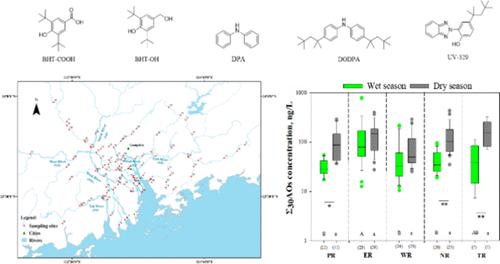Spatial and Seasonal Distribution, Source Apportionment, and Risk Assessment of Dissolved-Phase Ultraviolet Absorbents and Synthetic Phenolic and Amino Antioxidants in the Pearl River Delta (PRD), China
引用次数: 0
Abstract
The occurrences of antioxidants (AOs) in aquatic environments, including ultraviolet absorbents (UVAs), synthetic phenolic antioxidants (SPAs), and amino antioxidants (AOAs), are receiving concerns due to potential risks to ecosystems and humans. In this study, we systematically elucidated the spatial and seasonal variation, sources, and risk assessments of 4 SPAs, 14 AOAs, and 12 UVAs in surface water in the Pearl River Delta (PRD). The total concentration of AOs (Σ30AOs) displayed significant seasonal trends, with a higher concentration observed in dry seasons. The median concentrations of Σ30AOs were 95 and 42 ng/L for the dry and wet seasons, respectively. BHT-COOH and BHT-OH, DPA and DODPA, and UV-329 were the most abundant SPAs, AOAs, and UVAs, respectively. Strong significant and positive correlations were observed between the population of local residents and concentrations of SPAs and AOAs (p < 0.001), indicating that the occurrences of SPAs and AOAs were influenced by anthropogenic activities. Source apportionment first revealed that AO contamination in the PRD mainly encompassed rubber manufacturing and plastic, resin, and polymer manufacturing, accounting for 61 and 25% of AOs in the PRD. The ecological risks were identified to be high for DODPA while the human health risks were found to have no adverse effects.

中国珠江三角洲(PRD)溶解相紫外线吸收剂及合成酚类和氨基抗氧化剂的空间和季节分布、来源分配及风险评估
水生环境中的抗氧化剂(AOs),包括紫外线吸收剂(UVAs)、合成酚类抗氧化剂(SPAs)和氨基抗氧化剂(AOAs),由于对生态系统和人类的潜在风险而受到关注。本研究系统地阐明了珠江三角洲(PRD)地表水中4种SPA、14种AOA和12种UVA的空间和季节变化、来源和风险评估。AOs 的总浓度(Σ30AOs)呈现出明显的季节性趋势,旱季浓度较高。旱季和雨季的 Σ30AOs 浓度中值分别为 95 和 42 纳克/升。BHT-COOH 和 BHT-OH、DPA 和 DODPA 以及 UV-329 分别是含量最高的 SPAs、AOAs 和 UVA。当地居民的数量与 SPA 和 AOA 的浓度之间存在极明显的正相关关系(p < 0.001),表明 SPA 和 AOA 的出现受到人为活动的影响。污染源分佈首先顯示珠三角的厭氧氣污染主要包括橡膠製造業和塑膠、樹脂及聚合物製造業,分別佔珠三角厭氧氣污染的61%和25%。经鉴定,DODPA 的生态风险较高,而人类健康风险则没有不良影响。
本文章由计算机程序翻译,如有差异,请以英文原文为准。
求助全文
约1分钟内获得全文
求助全文

 求助内容:
求助内容: 应助结果提醒方式:
应助结果提醒方式:


